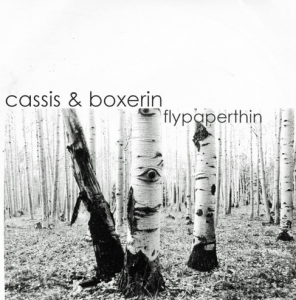 Artist: Cassis & Boxerin
Artist: Cassis & Boxerin
Title: Flypaperthin – A Symphonic Suite for Chamber Ensemble
Label: self released
Genre: singer-song writer/soundtrack/alternative rock
CD Review by Dawoud Kringle
The “classical” model of the chamber ensemble of Europe’s antiquity has clearly branched off into directions that Bach, Mozart, and Vivaldi could never have anticipated. Cassis & Boxerin is such a project.
Cassis & Boxerin grew out of a project in 2005. Cassis B. Staudt (a German film composer whose credits include Ferry Tales, Peter Patzak’s Zodiak Sign, Catharina Deus, About a Girl, and Living Lightly; leader of B-Blush, who’d toured Europe and Mexico and released the CDs ‘Analog Love, You Are Here, and Heartcore. was commissioned to write the score for the film Die Boxerin. Cassis approached Lars Schuy to record her musical compositions in England, and through Lars met Herbie Flowers who has worked for David Bowie (Space Oddity, etc), Lou Reed (Transformer), Henry Mancini (Pink Panther), and many others . They formed Boxerin. Their collaboration produced the CD Flypaperthin, which includes music from Die Boxerin and classical contemporary arrangements.
Flypaperthin features Cassis (piano, accordion), Helen Claire Lacey (cello), Herbie Flowers (bass), tuba), Lars Schuy (guitar, mandolin, ebow), Nick Pynn (violin, mandolin), Astrid Williamson (piano), Barry Morgan (percussion), Adam Bushell (drums, percussion), Ben Lauber (synthesizer), Bernd Medek (choir director), and Michael Hinton (choir director).
The CD starts with an Asian flavored mandolin tremolo that’s suddenly broken by angular melodies harmonized in 4ths and 5ths, and a pizzicato counterpoint on cello. As the piece progresses, electric guitar, accordion, and piano jump in and out of the forefront of the music until a beat directs the mélange toward the piece’s end.
As the CD progresses, it’s clear that Cassis is not as concerned with genres as with creating a mood. The second track (the title track, actually) mixes several distinct styles in a way that holds well together.
Some of the tracks take the music into subtly different directions, without deviating from the overall vision of the music. “Driving Forever” for example, employs a girl’s choir against an understated rock beat and strings in the background adding flavorful harmonies. “Anticipating Peace” has a watery, hypnotic feel that suddenly cuts off to jump to “Ghettofab on a String;” a string piece that seems incongruous in its beauty and contrast to its title. “Good Girly” experiments briefly with country music. “Fly Paper Sexy” is another track whose title contrasts sharply with the mood of the song. “Underground Floating” actually does float; the strings create an ethereal and dreamy feel.
There is a feel of intimacy about the music that draws one in without making any identifiable effort to do so. The majority of the tracks are short, averaging two and a half minutes long, and have the presence and personality of small, finely crafted works of art rather than songs as one would expect. Naturally, this is film music, but its very good on its own out of context of the film. A brilliant work.

